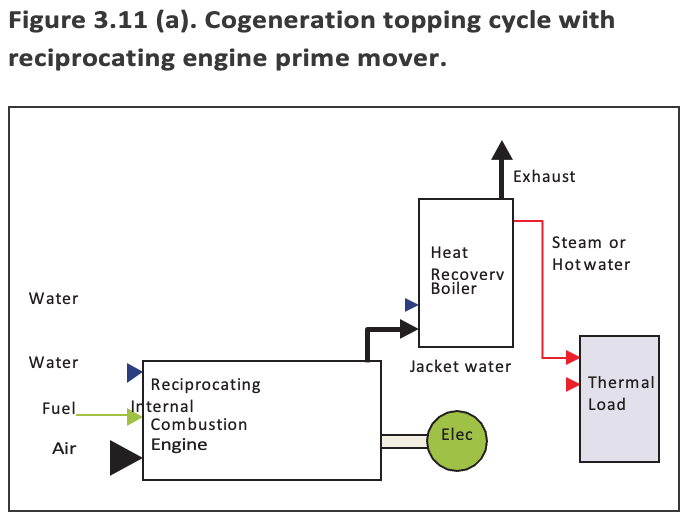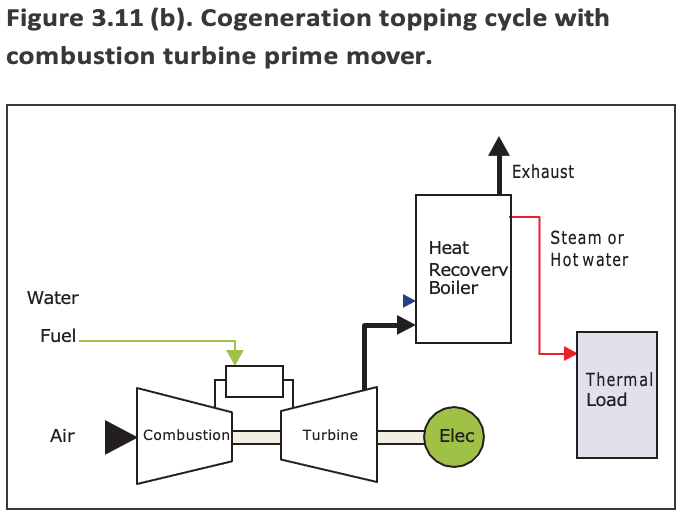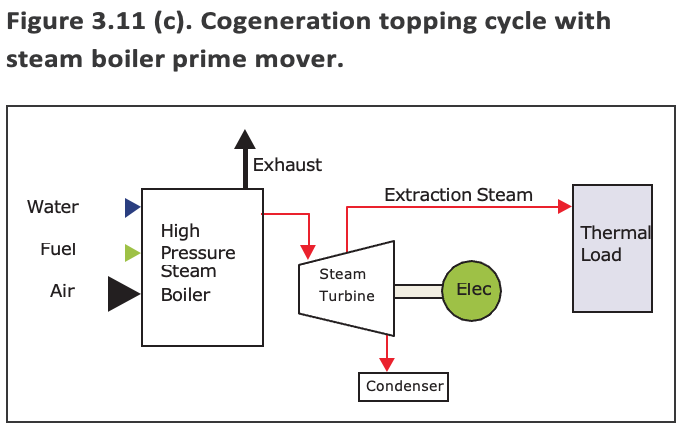Utilities are classified as electric; thermal (heating and cooling) for space conditioning; or thermal for process requirements, water, and sewer. Supplying a utility from a central production station is based on economies of scale (e.g., equipment, real estate, labor, operations) outweighing inefficiencies of the distribution system and required local converters (e.g., electric, water, sewer utilities). Central plant operations can extract useful mechanical energy (to turn an electric generator) and thermal energy (to generate steam, hot water, or both) from the same fuel source or cogeneration.
Cogeneration
Definition. Cogeneration has no single accepted definition. In this chapter, cogeneration is the sequential generation of electric and useful thermal energy from a single energy source, a term interchangeable with combined heat and power and with combined cooling, heating, and power (trigeneration).
Three basic cogeneration cycle configurations apply:
- A topping cycle (most common at universities) occurs when electricity is generated in the first process and rejected heat becomes an energy source for a subsequent process, such as heating and cooling (see Figure 11 a-c).
- A bottoming cycle occurs when the first process produces rejected heat that is used to generate electricity in the second cycle, usually with a waste heat recovery boiler to produce steam to drive a turbine generator (see Figure 12).
- A combined cycle includes both a topping and a bottoming cycle, producing electricity on both ends (see Figure 13).





Operations Management. Cogeneration systems are complex, interactive, and interdependent; many primary and secondary variables affect cost-effective operations (as can operating permit conditions or statutory requirement changes). Advance planning is needed for routine and preventive maintenance activities to minimize downtime. The engineering staff supports long-range planning and performance testing, design, and implementation of modifications. Cogeneration decision process data must be captured and preserved. Operators must understand how the system works, how to operate equipment, and how the plant and outside campus react to operating practices. A cogeneration system provides electric and thermal energy, but requirements for each are independent, so preferred operation mode depends on the root system justification. If the generator is connected and synchronized to the grid, basic operating scenarios are available to manage electric loads, thermal loads, and cogeneration system size.
Overview of Technologies. Cogeneration systems have a prime mover that consumes input fuel to drive the first process and equipment to recover waste heat to use in the second process. In this section, the first process is electricity generation, and prime movers (each explained) are (1) combustion turbines, with varying electrical efficiencies (smaller units tend to be less efficient, but even similar-sized units from different manufacturers can perform differently) and operating conditions with potentially larger impacts than initial equipment selection (e.g., part-load operations, dirty filters, inlet air temperatures warmer than rated temperature); (2) reciprocating engines, with high electrical efficiency and less sensitivity to part-load operations and inlet air temperatures; (3) steam turbines, with electrical efficiency based on generator sizing and (more important) exhaust conditions; and (4) fuel cells, with battery-like operations (see Figure 3.14).

Performance Ratings. Marketing data and cogeneration system nominal ratings are based on standard test conditions and assumptions that allow product and manufacturer comparisons but can set unrealistic performance expectations. Rating characteristics include combustion turbine performance specified at ISO standard conditions, fuel input for combustion turbines and reciprocating engines based on lower heating value, electric power output typically quoted at generator terminals, and recoverable heat claimed dependent on temperature assumptions.
Fuels. Cogeneration system fuel selection affects equipment specifications and performance. Primary fuel selection depends on availability, quality, pipeline or truck delivery, onsite storage needs, and backup fuel source needs. Options include natural gas (preferred primary fuel; clean burning, high quality; wide distribution pipeline; propane as backup fuel source); fuel oil (no. 2; quality standards met but limited use as primary fuel; possible air permit requirements; backup for natural gas in dual-fuel installations); coal (complex fuel; significant emissions issues; gasification technology not commercially viable); biogas, digester gas, and landfill gas (alternative renewables composed mainly of methane and carbon dioxide; site-specific quantity and quality; possible impact on equipment warranties); and biomass (renewable; site-specific quality and quantity; moisture content issue; gasification technology still under study).
Waste Heat Recovery. Waste heat recovery systems must be designed for the specific application (typically heat recovery to generate steam and hot water). Special applications use exhaust in direct-contact drying processes, air-to-air heat exchangers, or hot oil heat recovery.
Regulatory Issues. Key legislation on fair treatment of cogeneration system owners is national, but regulations vary by political and geographic region (e.g., exemption from rigorous utility scale generator process, environmental impact statement, air emissions permit, air emissions permit to construct, electric interconnection agreement). As other examples, planned installation specifics can dictate other studies, permits, and agreements; and adjacent properties can raise concerns (e.g., noise, viewshed, traffic flow).
Screening Checklist for Cogeneration. Many questions must be addressed early and revisited as needed during the cogeneration system assessment process, including (1) reasons for cogeneration, such as specific quantifiable defined needs (e.g., increased reliability, energy cost savings, infrastructure upgrade, suitable year-round thermal load, future energy requirements); (2) availability of historical operations data to evaluate potential for higher future costs for some budget items, supplemented by additional data collection; (3) people who will perform the evaluation (e.g., preliminary screening by in-house staff; later external assessment by experts); and (3) final decision- maker (many stakeholders, but one can say yes).
Alternative Electric Generation
Depending on the site, solar photovoltaics and wind turbines can fit a renewable energy portfolio; their diffuse and intermittent nature makes them a supplement (not a replacement) for the grid or cogeneration.
Photovoltaics. Made of semiconductor materials (usually silicon), photovoltaic (PV) cells generate electricity from light. The three silicon cell types are based on cell structure (monocrystalline, polycrystalline, amorphous silicon), with different costs and efficiencies. Most practical solar PV applications use rigid flat panel assemblies of monocrystalline or polycrystalline cells, with fixed-array, single-axis tracking, or dual-axis tracking (active or passive). Manufacturers provide solar panel ratings at standard test conditions (STC) or PVUSA Test Conditions (PTC); solar cell temperature is higher for PTC, resulting in a lower power rating. PV cells generate DC electricity, and power ratings are measured in DC watts, so inverters convert to AC. Inverter losses, module mismatches, wind losses, and other factors reduce output; the peak AC output rating is about 75 to 80 percent of the DC rating. Solar PV systems operate automatically, but operators monitor inverter malfunctions and binding of tracking mechanisms. Annual maintenance (e.g., inspection; solar panel cleaning; sensor and actuator calibration) is needed. A tracking system reduces the number of arrays in an area because shading of adjacent arrays is minimized. Weather conditions and timeliness of corrective responses affect array output. PVWatts, a free online calculator from the Department of Energy National Renewable Energy Laboratory (NREL), is a relatively easy and quick tool for estimating annual power production.
Wind Turbines. Wind turbines convert kinetic energy in wind to mechanical energy to drive an electric generator. The two types are based on rotation axis, vertical or horizontal (main type for commercial power generation). NREL uses wind power density to rate wind resource potential on a scale of 1 to 7; wind speed increases for each class by about 25 percent, and power density doubles between 10 m and 50 m above surface level, the two common reference elevations (Class 3 is the minimum for grid-connected wind turbine applications). Wind characteristics vary by terrain and obstructions (e.g., other wind turbines in multiple-unit installation, vegetation, structures), so site-specific data are needed. Wind turbine certification is based on IEC Standard 61400 compliance, but annual output estimates and performance curves vary for units with the same power rating depending on many factors (e.g., rotational speed, gearing, tower height, blade swept diameter) that also affect cut-in (starting) and cut-out (stopping) wind speed, survival wind speed, noise, and weight. (1) The primary operations objective is to keep complex wind turbine systems available so turbines run when the wind blows. The turbine controller enables automatic operation, but a minor component failure can shut down the turbine. A qualified staff must implement an O&M plan based on manufacturer-defined tasks and frequency (e.g., inspection, blade cleaning, oil and filter change, sensor and actuator calibration, new brake pad and seal). (2) Regulatory constraints vary (e.g., no special requirements; formal permit process with environmental impact and mitigation analysis; U.S. Fish and Wildlife Service and state wildlife agency project permitting if wildlife or habitat is affected; FAA approval if structures are more than 200 feet tall or near airports).
Evaluating the Business Case
The business case quantifies economics in a financial model to support sound financial decisions (e.g., ownership costs and sensitivity to major variables). Such knowledge is useful in contract negotiations with fuel and utility suppliers (cogeneration or not), as the basis for reconsidering the decision if major variables change, and as the basis for monitoring performance and making strategic decisions about future operations management. The financial analysis includes explicit or implied data or assumptions regarding existing conditions and proposed conditions. The economic analysis for photovoltaics and wind turbines is simplified because these projects only generate electricity (valued in cost per kWh). Cogeneration outputs are electric and thermal utilities, so costs must be allocated to each output.
Valuing the Electric and Thermal Streams. Quantifying the value of electricity and heat recovery starts with the input fuel stream and three energy output streams (electricity, recovered useful heat, waste heat), but the proportion of each output stream can vary based on planned operating methodology. Values of an average system load are useful for cost allocations and comparisons. The waste heat stream can be split between the other two (e.g., demonstrated cogeneration cost less than purchased electricity cost; divided equally; allocated by output proportions). O&M system costs are included in valuing electricity and thermal production; full-service contract costs are a good estimate. If electricity is sold to the grid, a value for excess electricity is calculated based on system operation for incremental power increases.
Project Risks. Risk evaluation balances risks that apply to the proposed project against those for any alternatives (or no project). Common risks are associated with capital costs, new or obsolete technology, alternate fuel sources, future regional and global utilities and fuel costs (short term and long term), and O&M (purchase or generation). Such project risk elements overlap and interact. A contingency fund or project changes can be appropriate risk-mitigating strategies.
 Create an Account
Create an Account
 Login/myAPPA
Login/myAPPA
 Bookstore
Bookstore
 Search
Search  Translate
Translate 
Leave a Reply
You must be logged in to post a comment.